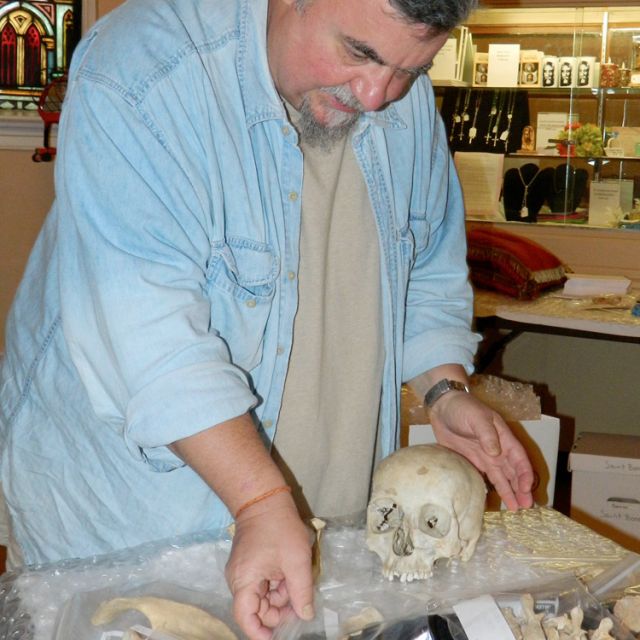In late May, their remains were removed from their reliquaries -- made of marble and glass -- and a team of researchers from the University of Louisville began examining the bones in a former chapel at St. Martin.
Philip DiBlasi, an archaeologist who teaches skeletal forensics at the University of Louisville, and four students are taking an inventory of the remains, determining their demographic profiles and hoping to learn even more about the pair of ancient saints.
While his research isn't complete, DiBlasi said during an interview with The Record, Louisville archdiocesan newspaper, that he has been astonished by the findings.
"I am really comfortable with (the notion) these (remains) are who they represent," he said. "I am frankly astounded that the demographic information (that was passed down in stories about the saints) is so close to what we have found."
Research into these relics was prompted by a couple of factors, said Father Fred Klotter, pastor of St. Martin. The side altars at St. Martin, in which the sarcophagi were encased, needed repairs and the glass sides of the cases were cracking, he said. Curiosity had a hand in the decision, too.
"We had talked about doing this for seven years -- since I've been here," said Father Klotter, noting the parish has no formal history of the relics.
"Respect made us very cautious," as did a concern about the possibility that the relics weren't real, he acknowledged.
"We didn't know what we were going to get," he said. "What we're finding is the common stories we passed down orally have been proven."
DiBlasi, who has also been helped by his archaeologist wife, Jan Marie Hemberger, said the investigation started on a low note, but quickly turned exciting.
"We initially unwrapped Magnus and I was disappointed," said DiBlasi. "He is very highly fragmented. He has a complete cranium, but no mandible.
"Then we unwrapped St. Bonosa and we were just astounded," he said. "She was in phenomenal condition. All the damage we see on her was from bad handling."
Her remains include a complete cranium, mandible and pelvis, which together can reveal important information -- including an accurate age. She was 24 years old, plus or minus one year, when she died, DiBlasi said.
The investigation aims to determine the stature, ancestry, gender and handedness of both saints.
"We will get all of that for her (St. Bonosa)," said DiBlasi. "On Magnus, we will get gender and ancestry. We will not get handedness or stature with him because he's so fragmented."
So far, DiBlasi's team has determined that "the male is 45-plus years of age," he said. "We will narrow that down, we hope. There is an 85 percent probability that he is white" though data also suggests Egyptian or other Mediterranean ancestry.
"There is some trauma to his cranium that could be related to his death, but I really need to spend some time looking at that," DiBlasi said. There's a possibility, he said, that the trauma occurred after death.
The most intact pieces of St. Magnus are the cranium and a partial femur.
"Every bone he has is so fragmented, the best we can do is get an inventory of the bones," DiBlasi said. "If he were more complete, I could say a lot about him, because as a soldier, there would be stress markers."
St. Bonosa seems to be 100 percent Caucasian.
"She's a white female between 5 feet and 5-feet 6-inches tall," DiBlasi said. "Her age is 24, plus or minus one year. That's pretty solid. The history that came with her suggested she was 16. We know she spent a lot of time squatting" by the wear that shows on her bones.
In addition to the research done by DiBlasi's team, Jewish Hospital donated a CAT scan of the two skulls. St. Bonosa's scan could lead to a facial reconstruction, Father Klotter said, provided funding could be found to cover it.
He and the students are conducting their research as volunteers. The archaeologist said he spends about 40 hours a week on the project and planned to do four weeks of research at St. Martin.
While he has worked with murder victims, DiBlasi said he's never worked with relics.
"This is very exciting," he added, noting that he's a member of St. Bartholomew Church. "To be a Catholic and to do this is way cool."

